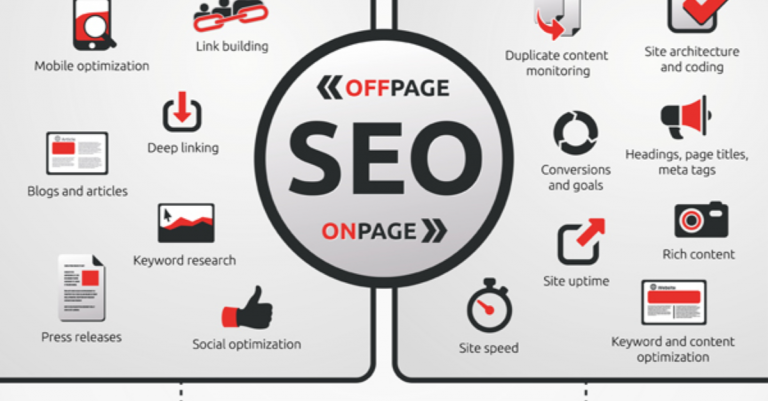SEO (Search Engine Optimization) is an online process of optimizing your website on top ranks of Google so that you can gain more Organic traffic. While on the other hand SEM (Search Engine Marketing) is also a process of gaining organic traffic but through a paid ads. SEO and PPC (Pay Per Click) both are part of SEM. So, here is a complete guide to SEO.
What is On-Page SEO?
On-page SEO is a term used to make any web page more unique, having more in-depth information and also have a trending Keywords that are major and current focus of the audience. A focused keyword must be long-tale word that will target more specific niche. Now here is the question that how can we discover the focused key word? The best way to work on focused key word is that one should search related keywords from the umbrella term so that the word become more specific and informative. It will also possible by taking help from Google suggestions. If we put any word in Google search than it will provide us more related and targeted words that are now a days in trend and demand. Other than this we can also find related key words at the end of search page.
Here are the main factors of ON-Page SEO:
- A targeted Title Tag line which is not more than 55-60 characters with space clearly convey the actual message in one line with focused keyword. The focused keyword must be in beginning.
- A well descripted Meta description having more details about the main and focused Keywords. It must be 150-160 characters with space. It is also known as an abstract or introductory paragraph.
- It must have a catchy H1 heading in HTML in which there is a complete overview of what the content or blog is actually about. It consists of all details that will be further more discussed in the article or blog. We need to make a good hierarchy by making signposts of H1, H2 & H3 because it will facilitate our audience to read the climax in the beginning. In this format First come H1 in which we give the major details than H2 which have less important details and at last H3 comes which is a concluded paragraph.
- At last we put more relevant and focused keywords “Internal links or CTR” (click through Page) into the article. It can improves the crawl ability of any website. Internal link must be more prominent and underlined so that reader can easily reach to the targeted website by just click on it.
What is crawl ability?
Crawl ability means a process of scanning websites by Google. Google can scan all websites or hyperlinks which have used same specific target keyword on which someone is searching. If you want to rank your website on top you must make it easy to find by having same or interlinked keywords through search engines.
Indexing: After crawling the given results will be organized and put into as an index list format. This list is called SERP (Search Engines Results Page) which will be given on top of Google search page according to its performance. Featured snippet also known as “position zero” is a selected search result that appears above the standard 10 results in SEPR. Its goal is to answer the user’s question directly in the form of paragraphs, lists and tables according to their niche and target keywords.
Effective On-Page SEO Have Main Mechanisms
It must be clear and have focused Keyword with exclusive and explanatory content on a certain niche.
Develop more and well-intentioned backlinks to a website content so that our website link may reach to maximum audience and we get organic traffic.
We can check On-Page SEO by using the following tools:
- To optimize for the Target keywords (SEO Crawler).
- To analysis Keyword Explorer (Ahrefs’)
- To check online plagiarism (Copyscape & Quetext)
- For crawling large and small websites (Screaming Frog SEO Spider.)
- To find and fix website speed problems (Google Developers PageSpeed Insight)
- To optimize the rank of website (Moz On-Page Grader).
What is Off-Page SEO?

Off-page SEO means we must evaluate our page as a user’s point by giving more flexible and easy content. It is mostly about getting quality backlinks to show search engines that your website has authority and value. Link building may involve techniques like (Guest blogging, Email outreach & broken link building). For this purpose off-page is further divided into two main categories; White Hat and Black Hat.
White Hat refers to all the regular SEO techniques that stick to the actual strategies and rules of Google it contains; natural links, quality content, brand building, content strategy & keyword research.
Black hat SEO is a set of unethical, fake and in against the Google practices to gain the rankings of a website but not focus on the organic traffic. It may include; Link manipulation, irrelevant backlinks, key word stuffing & spam comments.
Technical SEO Introduction and Tools.
Using the right tools to track and analyze your website’s performance at the user end, a web owner make sure that the content must be latest, original, unique and more informative, it should be well structured along with relevant pictures (use those pictures which are set on an accurate parameters of website and don’t try to use those picture or images that are very high in resolution it may slow down our web link ), try to use JPG, PNG, GIF or SVJ (simple logo and graphic illustrations),Use image-alt-tags or focused keyword tags so that if your image is taking time to load on the site so in the mean while a reader can easily read the image alt-tag text; it should be in HTML format, use worthy backlinks & hyperlinks; a backlink is a link from one page to another it is also known as domain page and it must be above from 20 rank position, content should be shareable on social platforms and at last the speed of website should be easily accessible by mobile phones, laptops and other devices. If your hosting has a poor server response time, the traffic may switch to another site. To secure these points website owners are use some different tools for Technical SEO analysis.
- To monitor, maintain, and troubleshoot a website(e.g. Google Search-Console)
- a traffic analysis tool ( Google Analytics)
- a backlink analysis tool ( LinkMiner)
- a rank tracker ( SERPWatcher)
- to check backlinks and SEO analysis (Ahrefs)
- to explore exact backlinks profile of any site (Moz’s Link Explorer)
- to plugin bunch of useful SEO-related functions and other web metrics directly to Excel (SEOTools for Excel)


